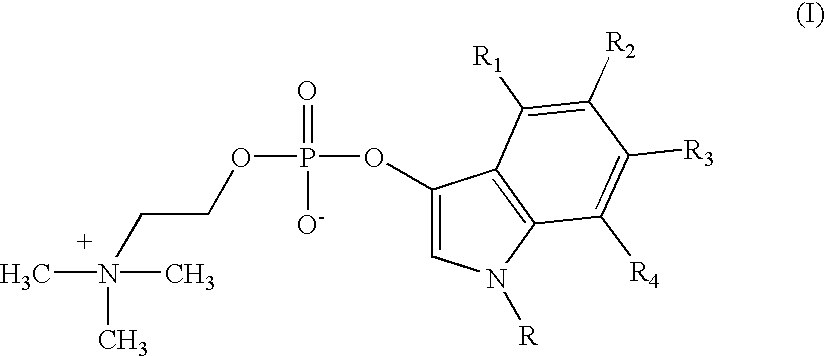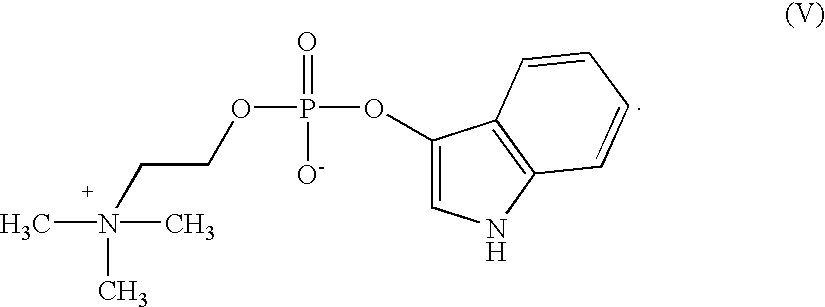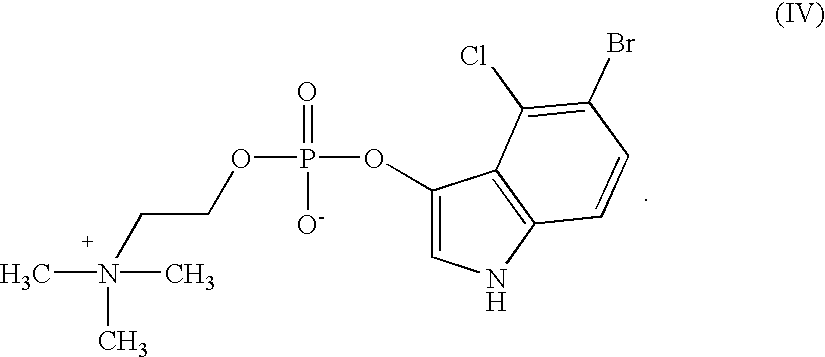Detection of microbial metabolites
a technology of phospholipase and metabolites, applied in the field of phospholipase c enzymes, can solve the problems of only suitable procedures, substrates less suitable for direct detection of microorganisms or microbial secretes, and the procedure is clearly not suitable for direct detection of microorganisms secreting pc, etc., to achieve the effect of easy and convenient detection of pc-pl
- Summary
- Abstract
- Description
- Claims
- Application Information
AI Technical Summary
Benefits of technology
Problems solved by technology
Method used
Image
Examples
example 1
Preparation of X-phos-choline (IV)
Step 1: Preparation of 1-Acetyl-5-bromo-4-chloro-3-indoxyl choline phosphate
1-Acetyl-5-bromo-4-chloro-3-indoxyl-dichlorophosphate (4.06 g, 10 mMol) was suspended under nitrogen in dry acetonitrile (12 ml) and choline iodide (2.31 g; 10 mMol) was added. The mixture was stirred at ambient temperature while quinoline (1.46 ml; 10 mMol) was added dropwise within a period of five minutes. Choline iodide dissolved slowly. A slightly turbid solution was obtained after one hour and stirred at the same temperature for a period of another 2 hours.
After removing some solid matter by filtration the clear brownish-yellow filtrate was added dropwise to a cooled (0-5.degree. C.) solution of pyridine (5.6 ml; 70 mMol) in water (20 ml).
The solution was evaporated under reduced pressure to yield a yellow-brown oil which was dissolved in water (60 ml). Mixed-bed exchange resin MB-150 (Sigma # A-5710; 60 g) was added and agitation was continued for a period of 20 minut...
example 2
Preparation of 3-Indoxyl choline phosphate (V)
Step 1: Preparation of 1-Acetyl-3-indoxyl choline phosphate
1-Acetyl-3-indoxyl-dichlorophosphate (8.76 g, 30 mMol) was suspended under nitrogen in dry acetonitrile (36 ml) and choline iodide (6.93 g; 30 mMol) was added. The mixture was stirred at ambient temperature while quinoline (4.38 ml; 30 mMol) was added dropwise during 15 minutes. The choline iodide dissolved slowly, and a slightly turbid solution was obtained after 30 minutes. The solution was stirred at the same temperature for another hour. The brownish-yellow solution was then added dropwise to a cooled (0-5.degree. C.) solution of pyridine (16.8 ml; 210 mMol) in water (60 ml).
The solution was evaporated at 55-60.degree. C. under reduced pressure to yield a yellow-brown oil which was dissolved in water (60 ml). A small amount of solids was removed by filtration. Water (105 ml) was added to the filtrate, and a mixed-bed exchange resin MB-150 (Sigma # A-5710; 90 g) was added. Agi...
example 3
Evaluation of the Proper and Preferred Additive or Combination of Cleavage Rate Enhancers for Clostridium perfringens PC-PLC
Simple test tube experiments were conducted to select a preferred additive or additive combination for quick color formation from X-phos-choline (X-CP) by enzymatic hydrolysis with PC-PLC of Clostridium perfringens.
Preliminary tests at .apprxeq.40.degree. C. showed that a slight enhancement of the cleavage rate of the enzyme was obtained when using octyl-.beta.-D-thiogalactopyranoside (Biosynth O-2700) at 0.1%; octyl-.beta.-D-thioglucopyranoside (Biosynth O-2710) at 0.1%; N-nonanoyl-N-methyl-glucamin (Fluka 74315) in the range 0.1% to 1%; and the sodium salt of glycocholic acid (Sigma G-7132) at 0.1%, to X-CP (the values given in % indicate the additive concentration in weight per volume). For all these detergents and surfactants, respectively, no additional enhancement was observed when combined with BSA.
Further experiments were conducted at 60.degree. C., whi...
PUM
| Property | Measurement | Unit |
|---|---|---|
| time | aaaaa | aaaaa |
| temperature | aaaaa | aaaaa |
| temperatures | aaaaa | aaaaa |
Abstract
Description
Claims
Application Information
 Login to View More
Login to View More - R&D
- Intellectual Property
- Life Sciences
- Materials
- Tech Scout
- Unparalleled Data Quality
- Higher Quality Content
- 60% Fewer Hallucinations
Browse by: Latest US Patents, China's latest patents, Technical Efficacy Thesaurus, Application Domain, Technology Topic, Popular Technical Reports.
© 2025 PatSnap. All rights reserved.Legal|Privacy policy|Modern Slavery Act Transparency Statement|Sitemap|About US| Contact US: help@patsnap.com



